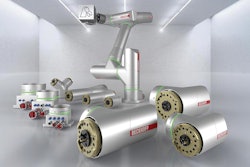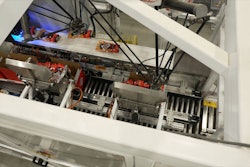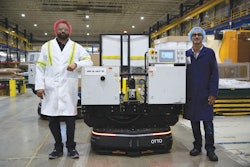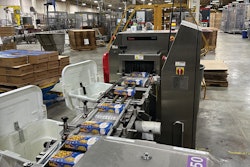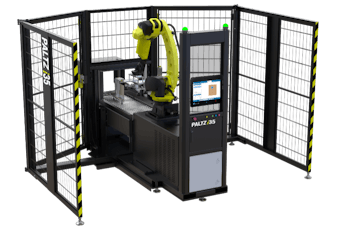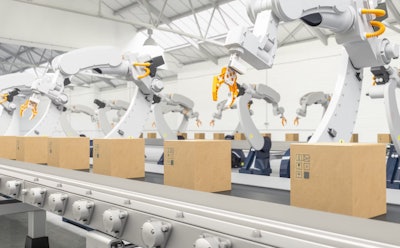
At ATX West 2023, a panel convened to discuss women’s perspectives on the path forward for robotics. Here are seven key takeaways on boosting colleagues’ careers, innovation in the industry, and finding the next generation of automation experts. [Editor’s note: some answers have been edited for brevity.]
1. Embrace the power of sponsorship
Moderator Morgan Zandonella, engineering program manager at Medtronic Neurovascular, highlighted sponsorship—an act that differs from more widespread mentorship—and can make a major impact in a person’s career. “Something that's come up a lot recently is the difference between mentorship and sponsorship. I'm a huge believer in sponsors,” Zandonella said. “The difference there is being that advocate when that person is not in the room. I've had the pleasure of having that happen—unbeknownst to me—to have someone who's not only talking with you, but talking to others about you. That really opens up connections and opportunities that a lot of underrepresented groups don't have the opportunity to have in the same way. So to be a sponsor to advocate for others is a really powerful thing that we can all ask for and recognize.”
 | For more on the criticality of sponsorship in your career in those behind-closed-doors talks, check out this brief clip from Carla Harris’ TED Talk. |
2. Don’t overlook mentorship
The value of mentorship is also undeniable. As Laura Armstrong, robotics application engineer at Archytas Automation, noted, “I can speak for myself that I wouldn't be in the position I'm in without mentors. And I think that it's really important—it goes back to representation. If you can see it, you can be it. One really important piece of mentorship is showing up for someone in a way that they feel seen, that they feel heard, and that they feel encouraged to keep going in this career.”
Groups like SWE do valuable outreach to mentor girls/women in school, along with industry partners who pitch in with scholarships and funding, said Vinita Palaniveloo, senior software engineer at Miso Robotics.
All genders can add value via mentorship. “I also don't want to discount the value of male mentors in the workforce, as Laura mentioned,” added Zandonella. “Having a mentor, regardless of their diversity identifier, means a lot to have someone that believes in you, that supports you, because as we all know, the field of engineering is very challenging, there are going to be mistakes—we're trying to solve problems that haven't been solved before. So, to have a mentor that can really support and walk someone through that, whether it's a younger or older or a peer. I think it's incredibly valuable.” IME Panelists from left: Laura Armstrong; Courtney Fernandez; Vinita Palaniveloo; and moderator Morgan Zandonella.
IME Panelists from left: Laura Armstrong; Courtney Fernandez; Vinita Palaniveloo; and moderator Morgan Zandonella.
3. Stay vigilant about safety
Courtney Fernandez, application engineer at Universal Robots, is optimistic about all the different ways she’s seeing robots utilized now, far beyond the widely adopted pick-and-place robot for manufacturing. “I've programmed robots that were part of a dance production. I've seen robots playing with toys. At this point, I’m curious to see what somebody thinks of to do with a robot, because it's not just restricted to this industry anymore,” she said.
But she also reminded attendees not to become complacent around safety: “The other thing I would be cautious of is as these robots become friendlier looking… we have these humanoid robots, and I work for a company that makes a collaborative robot arm. But we can't get complacent around this machinery because it's still machinery. So it looks friendly, it's getting easier to use, and it's becoming more accessible for everybody. But it's still a robot. If you go willy-nilly around any piece of machinery, it has the potential to cause a problem if you don’t treat it with respect. So as things get easier to use, and more friendly looking, it’s still a machine, and we still need to have training and appropriate respect for it.”
4. Implement work-life policies that benefit everyone
Statistics for women working in engineering roles are often quite low. Palaniveloo hopes to see increased participation of women in the field, and noted recent statistics that show that 30% of the engineers who graduate are women, but they only make up approximately 14% of the engineering workforce. Many drop out after they graduate or leave the profession. “It all starts with the employer, creating a place to express and bring [employees’] creativity out. The second thing that's important to me is that I go back to a study by Kenan Institute of Private Enterprise, which highlights the need for female-specific work benefits,” she said. Though not everyone chooses to have children, these include maternity leave, and flexibility for childcare and parenting emergencies.
Zandonella added, “One thing Vinita and I were talking about was that those types of benefits benefit all employees, including the men that are fathers of those kids. A company policy that gives paternity leave is allowing that woman to also be empowered and be able to go back to work. So I feel that by offering those benefits, maybe at the urging of fellow women colleagues, it's really going to benefit the entire workforce. Because those benefits again are being applied favorably to everyone.”
5. Recognize the business value of inclusion
The panel discussed that while conversations around promoting diversity in engineering and manufacturing often jump ahead to solutions, it’s important to frame why diversity and inclusion are so important (aside from the obvious: being ethical).
When asked why it’s so important to retain women and people from various backgrounds to robotics and engineering, Armstrong explained, “I think diversity as a whole is important for any industry, because we all have different experiences, we all bring different skills to the table... so when you bring a team together that is diverse, you're just going to have way more creativity, knowledge, and experience. When you’re looking at all genders, all ages, all races, and all types of diversity, the more of that we have, the better the solution is going to be, in my personal opinion. I believe there are studies that show this as well. So I think that's a big thing to keep in mind: if we all look the same, we all are the same, we're only going to have a very narrow experience and vision for what we could create or could do together.”
Those differing perspectives can be key to viewing problems in a more solvable way. “I'm sure everyone has seen the meme where you’re looking at a cylinder from one side, and from the other side, it looks like a square. Perspective matters. If you have multiple viewpoints, to your point, to be able to look at a problem, you can solve it from multiple angles, which I think is really important,” said Fernandez. “Everybody has a different skillset to leverage, you don't all have to be good at everything. Regardless of race, age, gender, we all have these different skillsets that can be utilized. And it's not like we're walking around wearing a label of what those skillsets are. … So, there's different things that people bring to the table, and you really don't know what that is until you've actually bothered to extract that skillset from them or challenged them to use it.”
Armstrong added that no skill is better than another: “Whatever someone does bring to the table is just as important as what I bring to the table or what Courtney brings to the table. I think it's important to acknowledge, too, that we're all on the same playing field here, regardless of title or role, or any of those sorts of things. The more that we can respect each other in that way, the better the team is going to be.”
An organization will be far more successful when a variety of voices are being included. “I think that's why so often we see the words diversity and inclusion—how they get lumped together, it’s because it's one thing to have diversity. But if you don’t have that inclusion piece of valuing that opinion, of having space in that environment where you feel safe to share your ideas, that diversity is lost. It doesn't add value then because you're not seeking it and truly using it to its full potential,” Zandonella said.
6. Invest in education and don’t overlook community colleges
Prior to her work at Archytas, Armstrong spent most of her career in education, most recently teaching high school math and engineering. While Archytas has engineers that work on the primary business of integrating robotics for small- and medium-sized business, she is dedicated to developing educational content in her role. “My bosses are very supportive. Part of why they hired me was because of my educational background… We are primarily working with the community college level right now. We actually did a survey last year for hiring managers within manufacturing and 87% of them said that they wish that their new employees had more robotics experience. And 71% of them said they're looking to the community college level for those new hires. That was higher than for four-year degrees, so associate's degrees, two-year degrees,” she said. “When we talk with educators, we find that they know that but they're having a hard time getting students. They’ve told us that there are companies that have already hired students before the student even arrives on campus, that's how much there they are in need of somebody to work on a robot. And so that is a part of my job, but I will say I'm very, very lucky in that sense, because I do think education sometimes becomes a philanthropic thing and I'm fortunate to work for bosses who support education. And it's not an afterthought, it's leading the way.
Armstrong noted that this is something most companies could invest in a bit more. “As a former educator, it was my job as a teacher to go out and seek these things, nobody was really coming to me trying to help me as an educator. You know, educators are overworked and underpaid and so it's hard for them to find the time to go do those things as well. So if you're in a position where you can help with [engineering] education, I think it's a very rewarding piece of any company.”
 | Related Reading: In Business, Curiosity is Your Biggest Asset |
Universal Robots also invests in education, offering an education discount, and an Edu kit for purchase for technical colleges. “I spend one week a month doing training courses for people using these robots. We work with another instructor that teaches classes that are only other educators. So it won't be end users of robots, but teachers who will buy a robot and use it in their classrooms,” said Fernandez. “So I think UR does a good job of trying to promote not just the robot, but education and how to use the robot. They also have free online academy training, hours of totally free training. When I entered the industry about 11 years ago, any training I could get for under $500, I was all over it, so I think they do a really good job of making training affordable for people.”
7. Bolster complementary skills
Palaniveloo explained she’s optimistic about the job opportunities that robotics will open up. “What I like to be cautious about is we want women to get into robotics and engineering, and there's no doubt about the capability to do it. But we need to train them on other soft skills, such as training them how to handle the intellectual property… they might be creating a lot more of that. They can be entrepreneurs, so let's educate them on that,” she said.
Where is automation shifting?
Palaniveloo said she envisions more autonomous manufacturing taking place in the coming few years, and drew attention to the recent publication, Research on Structural Performance and Assembly of Led Lamps Based on Automatic Manufacturing, which is published in Journal of Interactive Design in Manufacturing. “These robots are going to be very affordable, and they are going to be very agile in that you can program them for one multifaceted operation,” she explained. “So in my perception, instead of having different workstations being specialized to perform one function, you're going to have one unit that can actually pick-and-place, assemble, and then label, pack, and send it so it’s going to be more like the Amazon warehouse style of automated manufacturing.”
As robotics are implemented more and more in manufacturing, Armstrong said, “I'm passionate about education. For me, personally, I like to focus on that in a way of ‘Who's going to fix those robots when they break? Who's going to design the new technology? Who's going to use these robots to integrate into systems? How are they going to be programmed?’ So I think a big part of this, too, should focus on education and the training of humans to do these jobs. You know, there's a lot of myths out there, one being that robots are going to replace humans. Well, they're not going to really replace humans if these humans are using the robots in applications, in integration, and in learning how to fix the broken robots. So a big part of this involves education, training, and the engineering side of it.”
